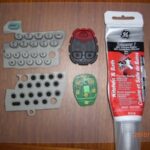If you’re involved in security systems, particularly those using key fobs, understanding the specifications of ID cards is crucial. The “CR8030” card is widely recognized as the industry standard size, used for everything from credit cards and membership passes to, importantly, access control and Key Fob Ids. This standard ensures compatibility and ease of use across various systems.
To break down the “CR8030” designation, “CR80” refers to the physical dimensions of the card. These cards measure 3.370 inches × 2.125 inches (or 85.60mm × 53.98mm), featuring rounded corners with a radius between 2.88 and 3.48 mm. This standardized size is what makes them universally accepted in card readers and key fob systems.
However, card size is only one aspect. What about the thickness of a key fob ID card? Is there a single standard thickness, or are there variations? Indeed, ID cards come in a range of thicknesses, measured in a unit called a “mil,” which equals 0.001 inch. Understanding these different thicknesses is vital for ensuring your key fob ID cards function correctly and are compatible with your access control systems and card printers.
We offer a variety of card sizes, including CR79, CR80, and CR100, each available in different thicknesses to meet specific needs. While we stock the most common thicknesses, we can also special order other thicknesses for large volume orders (minimum 5,000 cards). The most frequently requested cards are available in materials like PVC and composite, offering durability and flexibility. It’s worth noting that slight variations in thickness (a couple of mils) can occur between manufacturers.
Let’s explore the common card thicknesses and their typical applications, especially in the context of key fob ID systems and access control:
Common Key Fob ID Card Thicknesses and Uses
-
10-mil cards: Thinner than standard ID cards, 10-mil cards are often used for business cards rather than key fob IDs. It’s crucial to avoid using 10-mil cards with retransfer printers or printers with laminating or dual-sided printing capabilities. The heat involved can melt these thinner cards, potentially causing significant damage to your printer’s printhead and internal components, disrupting your ID card program. Furthermore, not all ID card printers are designed to handle 10-mil cards. Always verify your printer’s specifications before using this thickness.
-
13-mil cards: Similar to 10-mil cards, 13-mil thickness is more common for business cards or gym membership cards. While slightly more robust than 10-mil cards, they are still not ideal for standard key fob ID cards or for use with retransfer or laminating printers. Although some dual-sided printers might handle 13-mil cards, many can experience issues with double-sided printing at this thickness.
-
20-mil cards: Moving towards more durable options, 20-mil cards are often used for applications like bus tickets or mass transit passes. Their increased thickness means they may not feed correctly into all card printers. Always consult your card printer specifications before using 20-mil cards to avoid printing problems.
-
30-mil cards: This is the most popular and standard thickness for key fob ID cards and access control cards. 30-mil cards are also the standard for credit and debit cards, corporate ID badges, gift cards, and university ID cards. Their robustness and compatibility make them the industry-wide choice for a wide range of applications, including secure access systems linked to key fobs.
-
55-mil cards: Thicker cards like 55-mil are becoming less common for standard key fob ID applications in modern systems. Very few current printers can handle 55-mil cards (the EDIsecure XID 9300 is a rare example). Historically, 55-mil cards were used for luggage tags and, in niche cases, for award cards. They are generally not relevant for typical key fob ID card needs today.
-
60-mil & 65-mil cards: These thicknesses are commonly referred to as “clamshell” proximity cards. These robust cards are primarily used for access control and door entry, particularly in organizations with high employee turnover or contractor traffic. Their thickness provides durability and a robust feel, making them suitable for high-use environments where key fob IDs are frequently used for entry and exit.
Choosing the Right Thickness for Your Key Fob ID Cards
Selecting the correct thickness for your key fob ID cards is essential for functionality, durability, and compatibility with your card printers and access control systems. For most standard key fob ID card applications, 30-mil cards are the recommended and industry-standard choice. They offer a balance of durability, printability, and compatibility with most card readers and printers used in key fob access systems.
Understanding the different thicknesses and their applications will help you make informed decisions when choosing cards for your key fob ID system, ensuring smooth operation and secure access control.
